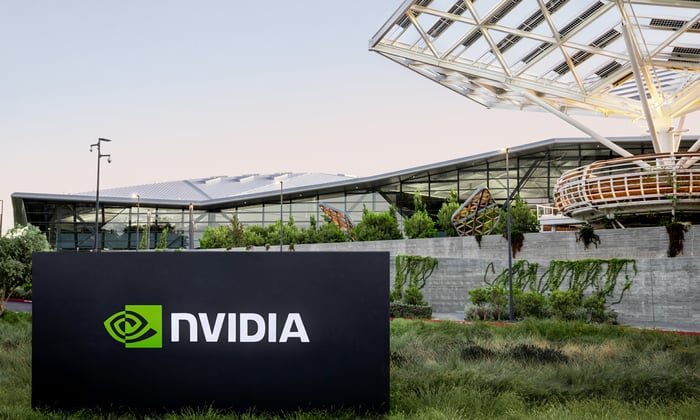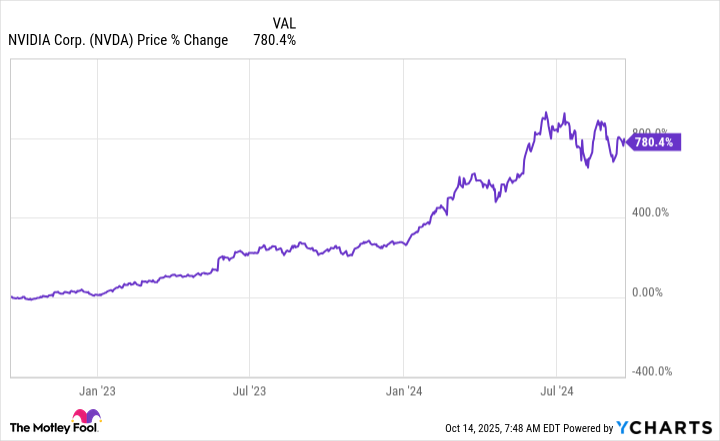Nvidia stock has skyrocketed over the past few years amid excitement about the company’s AI dominance.
About a year ago, Nvidia (NVDA 0.86%) was facing one of its biggest moments ever. The artificial intelligence (AI) chip giant was launching its new Blackwell architecture, a system that was being met with “insane” demand as CEO Jensen Huang told CNBC at the time. The company announced Blackwell in March 2024 and the fourth quarter of the year was the first to include Blackwell revenue.
Blackwell was to be the first release of a new routine for Nvidia: launching chip or entire platform updates on an annual basis. Since that time, this new architecture has helped Nvidia’s earnings roar higher, with Blackwell data center revenue climbing 17% in the most recent quarter from the previous one. In the report, Huang said, “The AI race is on, and Blackwell is the platform at its center.” Meanwhile, Nvidia stock has reflected all of this, advancing 40% so far this year.
Now, it’s logical to wonder where Nvidia will be as this story progresses, for example, 24 months after the Blackwell launch. Here’s what history says.

Image source: Nvidia.
Nvidia’s path in AI
First, though, let’s consider Nvidia’s path in the AI market so far. The company has always been a graphics processing unit (GPU) powerhouse, but in its earlier days, it mainly sold these high-performance chips to the gaming market. As it became clear that their uses could be much broader, Nvidia developed the CUDA parallel computing platform to make that happen — and then, as the potential of AI emerged, Nvidia didn’t hesitate to put its focus on this exciting market.
That proved to be a fantastic move as it helped Nvidia secure the top spot in the AI chip market — and the quality and speed of its GPUs has kept it there. All of this has resulted in several quarters of double- and triple-digit revenue growth as well as high profitability on sales — gross margin has generally surpassed 70% in recent times.
To keep this leadership going, Nvidia committed to ongoing innovation, with the promise of updating its chips once a year. The company kicked this off with the launch of Blackwell about a year ago, then released update Blackwell Ultra a few months ago. Next up on the agenda is the Vera Rubin system, set for release late next year.
From platform to platform
All of these platforms operate together seamlessly, so customers don’t have to wait for a specific one and instead can get in on Nvidia’s current system and easily move forward with the latest innovations when needed. Still, as mentioned earlier, demand from big tech customers for the latest systems has been great — they want to win in the AI race and to do so aim to get their hands on the best tools as soon as possible.
So, where will Nvidia be 24 months after the Blackwell launch? The clues so far suggest revenue will continue to climb in the double-digits — and Wall Street’s average estimates call for a 33% increase in revenue next year from this year’s levels. And as Rubin is released, demand is likely to increase for that system as customers’ interest in gaining access to the latest AI technology continues.
But what about Nvidia’s stock price? History offers some clues. Prior to this time, Nvidia’s major recent releases happened every two years. We can look back to the launch of the Ampere platform on May 14, 2020, and the release of Hopper on Sept. 20, 2022. And each time, over the next 24 months, Nvidia stock soared in the triple digits. It climbed 120% in the two years following the Ampere release and more than 700% following the release of Hopper.
What history says
History shows Nvidia stock is on track for a triple-digit gain two years after the Blackwell launch. If we use the starting point as the first quarter of Blackwell revenue — this quarter ended on Jan. 26, 2025 — we can see the stock has climbed about 30% so far. But Nvidia still has plenty of time to post more Blackwell sales and potentially see its shares advance in the triple-digits from their level earlier this year through the first month of the 2027 calendar year.
To illustrate, a 100% gain from early 2025 levels would bring the stock price to $284, and that would result in $6.9 trillion in market cap by the start of 2027. This fits into a scenario I wrote about recently, predicting Nvidia will reach $10 trillion in market value by the end of the decade.
Of course, it’s impossible to guarantee this outcome — any negative geopolitical or economic news, or even an unexpected problem like a decline in tech spending could hurt Nvidia’s revenue and stock performance. But, if these potential risks don’t materialize, history could be right — and Nvidia stock may find itself significantly higher 24 months after the Blackwell launch.

